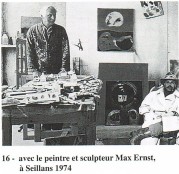
|
essay confirms that "it is possible to paint very complicated pictures without having the slightest idea of their real meaning" (Jung 1950:352). It is the poetic intuition, source of every form of knowledge, which guides Hamlet and makes him rediscover these remarkable coincidences between his iconographic motifs and the images which rise up from the collective unconscious. The last sculpture I wish to comment on is perhaps the one which best expresses the cult that Hamlet nurses for "the splendid feminine universe" (Hamlet dixit). In La Confessione (The Confession) the sculptor is in adoration at the feet of a female character who lifts her dress to show her gold-covered pubes. To show means to reveal, to disclose the essence of being. The golden veil of Isis is the manifested world and corresponds to the Peplos, the Veil of the universe in hermetic literature. Plutarch noted: "At Saïs the statue of Athena, which they identify whith Isis, bears this engraved epigraph: 'I am everything which has been, which is and which will be, and no mortal will ever lift my peplo'" (Isis and Osiris, 354 9c). Novalis imagined that "Someone managed to lift the veil of the goddess at Saïs. And what did he see? He saw - wonder of wonders - himself" (1798:67). This dialogue held after centuries clarifies the ambivalent nature of ritual nudity: deadly for the
|
layman, regenerative for the disciple. To be able to see one's own reflection in what constitutes the most intimate soul of the feminine means identifying oneself with it and healing the fracture between the two sides of one's personality. In other words, to reach the state of the homo totus of the alchemical tradition, of the hermaphrodite Adam Kadmon of the Kabbalah. This explains why rebirth was the reward for who had the audacity to contend with the unknown (one's own unconscious): in lifting the veil the disciple gained awareness, he identified with Isis and shared her immortal nature. A little before we saw the reasons which justify the association of the female organ with the processes of knowledge. The cult of the vulva (called yoni puja in India) also has very ancient origins of which we find the first iconographic testimonies not only in the statues of the Great goddess, as we already mentioned, but also in rock-engravings which date back to at least 5000 B.C. In 1982, during one of my study sojourns in India, I discovered an ideal antecedent of Hamlet's work. In the Chaunsat Yogini Temple of the X century, lost in the Orissa Jungle, I found one of the most perfect examples of Tantric cultural statuary: two couching worschippers, their hands joined in sign of devotion, are found on the two sides of the naked vulva of the seated Yogini Kamada. continue
|

